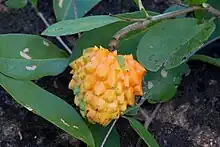Annona nutans
Annona nutans is a species of plant in the family Annonaceae. It is native to Argentina, Bolivia, Brazil and Paraguay.[3] Robert Elias Fries, the Swedish botanist who first formally described the species, named it after its recurved peduncles which give the flowers a nodding (nutans in Latin) appearance.[4][5]
| Annona nutans | |
|---|---|
 | |
| Photograph of an Annona nutans fruit.[1] | |
| Scientific classification | |
| Kingdom: | Plantae |
| Clade: | Tracheophytes |
| Clade: | Angiosperms |
| Clade: | Magnoliids |
| Order: | Magnoliales |
| Family: | Annonaceae |
| Genus: | Annona |
| Species: | A. nutans |
| Binomial name | |
| Annona nutans | |
| Synonyms | |
|
Annona nanofruticosa Herzog | |
Description
It is a bush 5 to 6 meters (16 to 20 ft) in height. Its branches have inconspicuous, brown lenticels. Its membranous, oval leaves are 3-5 by 2.5-3.2 centimeters with rounded apex that ends in an abrupt small point. The leaves are hairless on their upper surface and on their lower surface except along the midrib and veins when young. The leaves have 10 secondary veins emanating from each side of the midrib. Its petioles 2 millimeters long and have a groove on their upper side. Its recurved peduncles are 2.5-4 centimeters long, extra-axillary and usually emerge opposite a leaf. The peduncles are solitary or in pairs. The peduncles have a bract, covered in rust colored hairs, at their base and another at their midpoint. Its sepals are united to form a calyx with triangular lobes that come to a point. The outer surface of the calyx is covered in rust-colored silky hairs. Its petals are united to form a corolla, 1.5-2.3 centimeters in diameter, consisting of 3 broad lobes alternating with 3 narrow lobes. The outer surface of the corolla is covered in fine rust-colored hairs. The corolla is yellow to ochre-colored with purple spots on the inside. Its stamen are 1.8-2.2 millimeters long with flat filaments. The connective tissue between the lobes of the anther is extended to form a cap. Its flowers have multiple carpels that form a cone-shaped gynoecium. Its 4-sided, prism-shaped ovaries are 0.9-1 millimeters long. Its fleshy, quadrangular styles are 0.9-1 millimeters long and terminate in ovoid stigmas. The outermost styles are covered in fine glandular hairs. The mature orange fruit are 5 centimeters in diameter and 7 centimeters long.[6][5][7]
Reproductive biology
The pollen of Annona nutans is shed as permanent tetrads.[8]
Distribution and habitat
It has been observed growing in fields, sandy plains and valleys.[6]
Uses
It was described as being edible in 1914 by the American botanist William Edwin Safford.[7] The pulp of the wild, fresh fruit has been reported as being used as a food source in Brazil.[9]
References
- "Annona nutans (R.E. Fr.) R.E. Fr". Tropicos. Tropicos.org. Missouri Botanical Garden. n.d. Retrieved August 3, 2023.
- Botanic Gardens Conservation International (BGCI).; IUCN SSC Global Tree Specialist Group (2019). "Annona nutans". IUCN Red List of Threatened Species. 2019: e.T143321260A143321262. doi:10.2305/IUCN.UK.2019-1.RLTS.T143321260A143321262.en. Retrieved 20 November 2021.
- "Annona nutans (R.E.Fr.) R.E.Fr". Plants of the World Online. The Trustees of the Royal Botanic Gardens, Kew. n.d. Retrieved January 4, 2019..
- Stearn, William (2004). Botanical Latin. Portland, Ore. Newton Abbot: Timber Press David & Charles. ISBN 9780881926279.
- Fries, Rob (1905). "Die Anonaceen der zweiten Regnell'schen Reise". Arkiv för Botanik (in German and Latin). 4: 1–30.
- Chodat, Robert; Hassler, Émile (1904). "Plantae Hasslerianae soit Énumération des Plantes Récoltéeds au Paraguay par le Dr Emile Hassler, d'Aarau (Suisse) de 1885 a 1902" [Plantae Hasslerianae or List of Plants Harvested in Paraguay by Dr. Emile Hassler, of Aarau (Switzerland) from 1885 to 190]. Bulletin de l'Herbier Boissier. 2 (in French and Latin). 4 (11): 1155–1172.
- Safford, William E. (1914). "Classification of the Genus Annona with Descriptions of New and Imperfectly Known Species". Contributions from the United States National Herbarium. 18: 1–68.
- Walker, James W. (1971). "Pollen Morphology, Phytogeography, and Phylogeny of the Annonaceae". Contributions from the Gray Herbarium of Harvard University. 202 (202): 1–130. JSTOR 41764703.
- Bortolotto, Ieda Maria; Amorozo, Maria Christina de Mello; Neto, Germano Guarim; Oldeland, Jens; Damasceno-Junior, Geraldo Alves (2015). "Knowledge and use of wild edible plants in rural communities along Paraguay River, Pantanal, Brazil". Journal of Ethnobiology and Ethnomedicine. 11 (1): 46. doi:10.1186/s13002-015-0026-2. ISSN 1746-4269. PMC 4469002. PMID 26025294.
